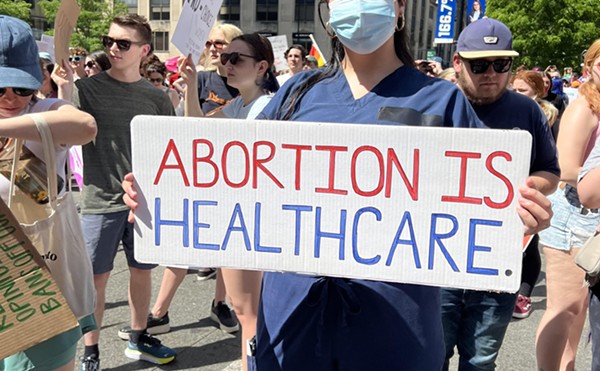COVID-19 masking requirements are a thing of the past for Cincinnati — at least for now.
The city of Cincinnati has lifted masking and testing requirements for city employees as well as for members of the public who enter city facilities. Cincinnati Mayor Aftab Pureval announced the change Tuesday morning after the Centers for Disease Control and Prevention (CDC) recently adjusted its guidance for how it reports the severity of COVID-19 cases as well as its recommended prevention tactics members of the public should take.
A March 8 press release from the mayor's office says that declining COVID-19 positivity rates, transmission rates and hospitalizations contributed to the decision for the city, which was made with information from the CDC, Ohio Department of Health and Cincinnati Health Department.
"Our city is in the best position we’ve been in since June 2021, and the CDC has moved our county to the lowest level of community impact. And because of these great results, we are again listening to the experts and making an informed decision based on the data," Pureval said.
Likewise, there is no longer a masking requirement for employees of Hamilton County, County Commissioner Denise Driehaus told reporters on March 2, though she added that many employees continue to wear them to help protect others as well as themselves.
On Feb. 25, in a data-based adjustment from previous guidance, the CDC said that instead of relying just on infection rates to determine if an area has a "low," "medium" or "high" instance of COVID-19 spread, the agency is now using three metrics:
- new COVID-19 admissions per 100,000 population in the past 7 days
- the percent of staffed inpatient beds occupied by COVID-19 patients
- and total new COVID-19 cases per 100,000 population in the past 7 days
The CDC does, however, continue to recommend indoor masking in areas with high spread. The CDC notes that "at all levels, people can wear a mask based on personal preference, informed by personal level of risk" and that those who have symptoms, exposure of who have tested positive should wear a mask.
Cautiously Looking Ahead
Cincinnati and Hamilton County officials had announced their latest rounds of masking and testing requirements as state-of-emergency declarations in January when COVID-19 cases and hospitalizations were sharply increasing, largely due to the Omicron variant of the coronavirus. During a Jan. 12 briefing with reporters, Deborah Hayes, president and CEO of The Christ Hospital, said that Omicron "spreads almost as, if not as, easily as measles."
After sustaining a months-long summer spike in COVID-19 cases due to the Delta variant, local healthcare leaders had stressed this winter that hospitals and other care facilities had become strained with Omicron variant patients as well as with a build-up of patients who had put off vital procedures at other points during the pandemic, which has lasted for two years and counting. Many hospitals had reported being at or over 100% capacity since mid-December as Omicron cases doubled every week.
But in recent weeks, COVID-19 cases in Greater Cincinnati have decreased due to layered mitigation factors like masking requirements and an increase in vaccinations, officials say. Likewise, health leaders say that hospital capacity is more manageable, though healthcare workers still are fatigued from two years of sustained overtime.
"I am happy to share that our hospitals in the region have weathered this storm and are back up and running. They are ready and safe to take care of you and your families, that’s a big deal for us," Craig Brammer, CEO of The Health Collaborative, said Tuesday.
As a result, Greater Cincinnati entities are making masks optional. On March 7, Cincinnati Public Schools updated its masking policy, saying that masks were no longer required in its facilities and vehicles. There are requirements in place for those who test positive for COVID-19, however, and CPS says masking protocols could return if local COVID cases spike again.
Cincinnati's entertainment venues also are updating their COVID-19 protocols. Music Hall officials said that starting March 14, guests will no longer be required to show proof of vaccination or a negative COVID test to enter, and masking will be optional. This affects those attending or working a Cincinnati Ballet, Cincinnati Opera, Cincinnati Symphony Orchestra, Cincinnati Pops or May Festival performance.
Individual businesses and organizations may continue to implement masking, social distancing, testing and other COVID-19 safety protocols.
COVID Science
Virologists and other experts agree that the coronavirus spreads through the air via fine aerosol particles that can linger for hours, which is why scientists strongly recommend wearing masks — especially when indoors or among large groups — practicing physical distancing, having good ventilation and moving airflow, and avoiding large gatherings.
Scientific studies have shown that public masking can block a high percentage of coronavirus particles from spreading to others and can protect the wearer, as well — even when not everyone does so. The CDC recommends well-fitting masks that a person will wear consistently. Studies show that N95 masks generally are best at blocking most of the coronavirus' particles.
Scientists also have said that getting one of the three COVID-19 vaccination series available in the United States (Pfizer, Moderna or Johnson & Johnson) greatly protects people from severe illness and likely hospitalization should they be exposed to the coronavirus, including its variants like Omicron and Delta. Adding a booster provides even more protection against serious health challenges or death, experts say. And though even vaccinated people can still contract COVID-19, they are much less likely to need hospitalization. Most hospitalized COVID patients are unvaccinated, medical staff say.
COVID-19 vaccinations are available to people ages 5 and older. Boosters are available to everyone 18 and up as well as to teens ages 12-17 years old who have completed the Pfizer vaccine series.
Stay connected with CityBeat. Subscribe to our newsletters, and follow us on Facebook, Instagram, Twitter, Google News, Apple News and Reddit.
Send CityBeat a news or story tip or submit a calendar event.






